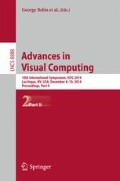Abstract
During movie production, movie directors use previsualization tools to convey the movie visuals as they see them in their minds eye. Traditional methods of previsualization include hand-drawn sketches, storyboards and still photographs. Recently, video game engines have been used for previsualization so that once the movie set is modeled, scene lighting, geometry, textures and various scene elements can be changed interactively and the effects of many potential changes can be previewed quickly. The use of video games for previsualization involves manually modeling the movie set by artists to create a digital version, which is expensive. We envision that a computational photography camera can be used for capturing images of a physical set from which a model of the scene can be automatically generated. A wide range of possible changes can be explored interactively and previewed on-set including scene geometry and textures. Since our vision is large, we focus initially on an initial prototype (a computational photography camera and previsualization algorithms), which enable scene lighting to be captured, inferred, manipulated and new lights applied (relighting). Evaluations of our light previsualization prototype shows low photometric error rates and encouraging feedback from experts.
Access this chapter
Tax calculation will be finalised at checkout
Purchases are for personal use only
Preview
Unable to display preview. Download preview PDF.
References
Okun, J.A., Zwerman, S.: The VES Handbook of Visual Effects: Industry Standard VFX Practices and Procedures. Focal Press, ElsevierScience (2010)
Adams, A., et al.: The frankencamera: an experimental platform for computational photography. In: Proc ACM SIGGRAPH (2010)
Warner brothers, HBO Entertainement, and Fox Searchlight Pictures. Movie collage (April 2011)
Raskar, R., Tumblin, J., Mohan, A., Agrawal, A., Li, Y.: Computational photography. ACM / EG Computer Graphics Forum 25(3), 1–20 (2006)
Lindsay, C.: Programmable Image-Based Light Capture for Previsualization, PhD Dissertation, Worcester Polytechnic Institute (January 2013)
Ruppertsberg, A.I., Bloj, M., Hurlbert, A.: Sensitivity to luminance and chromaticity gradients in a complex scene. Journal of Vision 8(9) (2008)
Bhat, P., Lawrence Zitnick, C., Cohen, M., Curless, B.: Gradientshop: A gradient-domain optimization framework for image and video filtering. ACM Trans. Graphics 29(2), 10 (2010)
Reinhard, E., Ashikhmin, M., Gooch, B., Shirley, P.: Color transfer between images. IEEE Comput. Graph. Appl. 21(5), 34–41 (2001)
Edward, J., Dowski, R., Cathey, W.T.: Extended depth of field through wave-front coding. Appl.Opt. 34(11), 1859–1866 (1995)
Levin, A., Fergus, R., Durand, F., Freeman, W.T.: Image and depth from a conventional camera with a coded aperture. ACM Trans. Graph. 26(3), 70 (2007)
Liang, C.-K., Lin, T.-H., Wong, B.-Y., Liu, C., Chen, H.: Programmable aperture photography: Multiplexed light field acquisition. ACM Transactions on Graphics 27(3), 55:1–55:10 (2008)
Nayar, S.: Computational cameras: Redefining the image. IEEE Computer Mag., 30–38 (August 2006)
Nayar, S., Branzoi, V., Boult, T.: ProgrammableImaging using a Digital Micromirror Array. In: IEEE Conference on Computer Vision and Pattern Recognition vol. I, pp. 436–443 (June 2004)
Petschnigg, G., Agrawala, M., Hoppe, H., Szeliski, R., Cohen, M., Toyama, K.: Digital photography with flash and no-flash image pairs. In: ACM Trans Graphics (Proceedings of SIGGRAPH 2004) (2004)
Raskar, R., Agrawal, A., Tumblin, J.: Coded exposure photography: motion deblurring using fluttered shutter. ACM Trans. Graph. 25(3), 795–804 (2006)
Zhang, L., Nayar, S.K.: Projection Defocus Analysis for Scene Capture and Image Display. ACM Trans. on Graphics (July 2006)
Raskar, R., Tan, K.-H., Feris, R., Yu, J., Turk, M.: Non-photorealistic camera: depth edge detection and stylized rendering using multi-flash imaging. In: ACM SIGGRAPH 2005, p. 2. ACM (2005)
Nayar, S., Branzoi, V.: Adaptive Dynamic Range Imaging: Optical Control of Pixel Exposures over Space and Time. In: IEEE Intl. Conf. on Computer Vision, vol. 2, pp. 1168–1175 (October 2003)
Author information
Authors and Affiliations
Editor information
Editors and Affiliations
Rights and permissions
Copyright information
© 2014 Springer International Publishing Switzerland
About this paper
Cite this paper
Lindsay, C., Agu, E. (2014). 3D Previsualization Using a Computational Photography Camera. In: Bebis, G., et al. Advances in Visual Computing. ISVC 2014. Lecture Notes in Computer Science, vol 8888. Springer, Cham. https://doi.org/10.1007/978-3-319-14364-4_87
Download citation
DOI: https://doi.org/10.1007/978-3-319-14364-4_87
Publisher Name: Springer, Cham
Print ISBN: 978-3-319-14363-7
Online ISBN: 978-3-319-14364-4
eBook Packages: Computer ScienceComputer Science (R0)

